Since its very inception, Warhammer has used an “I-go-U-go” system to divide player turns, but that system has always been problematic. Maybe it’s time to move on to something more balanced.

Warhammer 40K is, to be generous, a creaky old beast. Although 8th Edition jettisoned a lot of the most venerable aspects of the game, many others (such as the basic Space Marine statline, most weapon profiles, the basic system of attack resolution, etc) date all the way back to the game’s infancy in the late 1980s- a genesis which now predates the birth dates of most of the game’s players. For its time, 40K was a very innovative game and took a lot of unusual steps, but in the past three decades game design has come a long ways and many of those lessons have yet to be taken up by GW, much to the game’s detriment.
But of all of the artifacts of yesteryear that plague the game, perhaps the worst offender is the I-go-U-go” turn system, at least from a mechanical perspective. Put simply, I-go-U-go means that the turn sequence proceeds with one player starting their turn, taking all of their actions through to completion, and then handing the turn over to the other player, who does the same. When it isn’t your turn, you don’t get to do anything- with certain rare exceptions.
Now, there’s nothing fundamentally wrong with this turn system; it is used to great effect in many board games, including many wargame-styled board games. It has a variety of advantages, not the least of which being reducing the complexity of the game- when I’m doing my thing, that is all that is happening, and you don’t have a chance to interrupt me or make any decisions that might slow the game down. And this model is well-suited to games that want to be played in the course of an hour or two while having three, four, or even five players participating. It’s also used in almost all tabletop roleplaying games, where each individual player has their character perform all of their actions for the turn before passing on to the next player (or monster.)
However, modern 40K has moved beyond its roots as a board game and as a roleplaying game and become something wholly different- and I think that this shift necessitates changes in how the game should progress, especially as the size of armies continues to increase with every edition. In 2E, an army might consist of one or two tanks, half a dozen infantry squads, and handful of characters- but in 8E, that is probably only one detachment from a player’s army, with 2-3 such detachments expected. It’s not at all unusual for an army to consist of 20-30 units (and sometimes even more), every one of which that player will have to activate on each of their turns.
So what I’m proposing instead is alternating activations, a system that in fact is common to most popular wargames these days. To contrast with I-go-U-go, alternating activations says that while each player will still get to activate all of their units every turn, those turns are shared with the opponent. Most typically, this means that I will get to act with one of my units, then you will get to act with one of yours, then back to me again, etc. The advantages of this style of play (as opposed to the current one) are innumerable, but I’d like to touch of some of the biggest ones in sequence here.
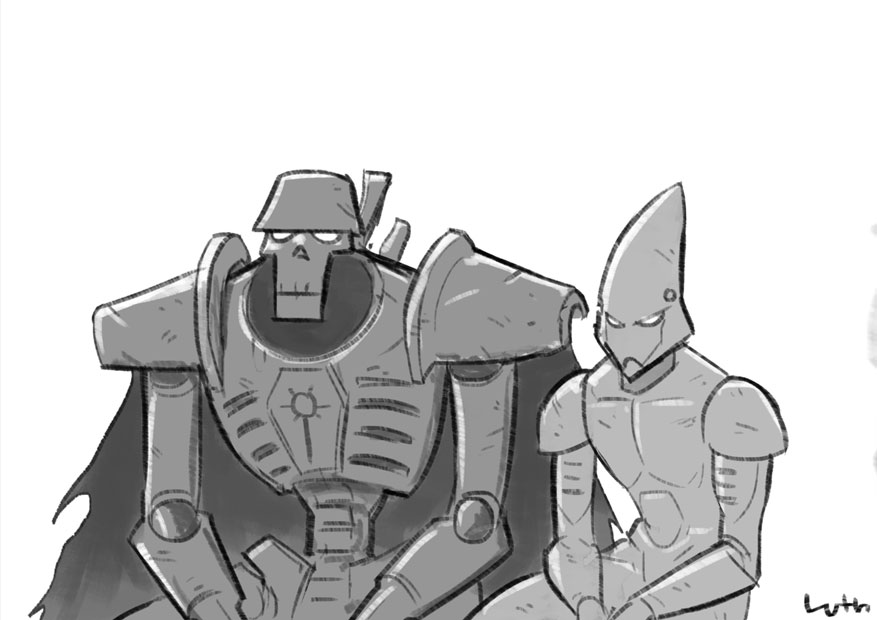
Less Dead Time
One of the biggest problems with I-go-U-go is that, during the enemy’s turn you aren’t doing anything. This is, of course, somewhat by design, but it also is problematic because in Warhammer turns can take so long. It’s not unusual to see a player’s first turn go for forty minutes or even an hour during a tournament- to say nothing of casual games where time limits aren’t enforced and the atmosphere is more casual. Having one of the two players be essentially noninteractive during that time can result in extreme boredom even in the best of cases- and while 40K does give the player some extremely token actions to take (such as rolling Deny the Witch tests or armor saves), I don’t think anyone would argue that there are many choices to be made compared to having the active turn. It’s not simply that you aren’t playing for 50% of the game- it’s that you aren’t participating for long stretches at a time, which enhances the feeling of noninteractivity.
This is especially problematic from the perspective of perception, because when it comes to holding a player’s interest in a game perception of how they see the game is arguably just as important as the reality of how the game functions, and I think 40K has this problem in spades. If you spend the first one third of a game doing nothing but watching as the enemy sweeps your army off the table, you may become extremely disheartened with the situation even if you still stand a reasonable chance of winning. This is part of why so many of the best players emphasize the mental portion of the game, but it’s a particular problem for those who are newer to the game or who may not have the same deep and abiding interest in it- if such players consistently have negative experiences with those sorts of situations, they may decide that the game is unfair and abandon it before even having a chance to advance to the point where they understand the mechanics of what’s happening and how they can get past it. Removing barriers of entry is paramount for maintaining the health and growth of a hobby, and in this respect mental barriers can be just as important as other ones.
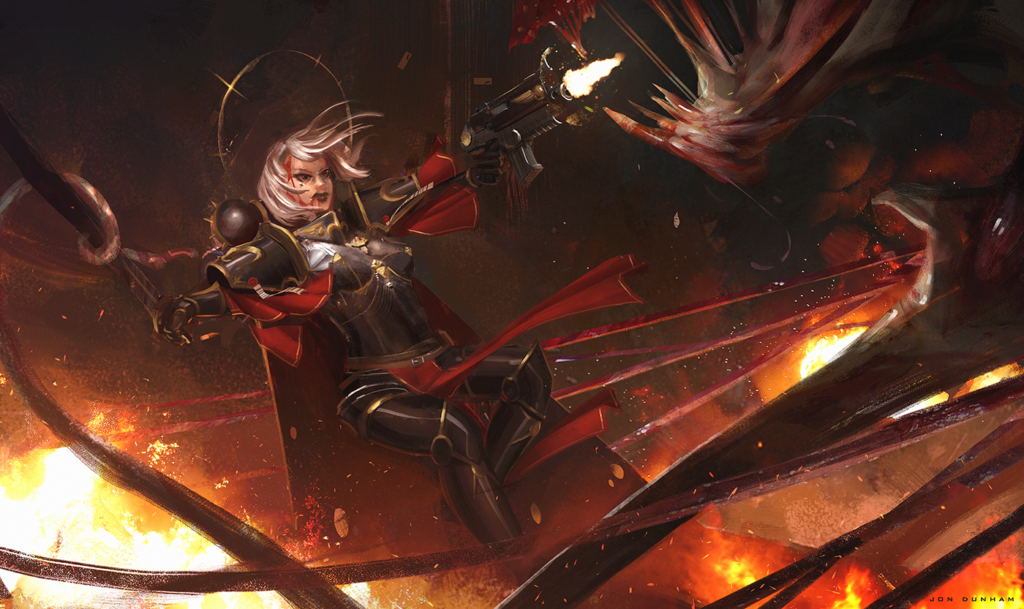
More Interaction and Counterplay
Going for half an hour or more without getting to do anything obviously drains a lot of interest from the game, but it also has other issues- namely, that it can remove a lot of potential strategy from the game as well. When a player is assured that they will get to activate all of their units without interruption or interference from the enemy, it removes a lot of potential for the enemy to disrupt that strategy. And that’s not a good thing! Wargames, even games in general, are all about disrupting the opponent’s plan while advancing your own. Obviously it is possible to do this within the context of Warhammer, but you are more limited in your ways to do so because you cannot interfere with the intermediate steps in many of their plans; if they decide “I’m going to shoot at his Gaunts first to remove them and then charge the Tyranid Prime”, then there really isn’t anything you can do about that. But if you had the opportunity to interrupt their plan with a response of your own- say, but shooting one of your units at the unit that was going to charge the Prime- then that is an opportunity for you to make decisions that affect the way the game plays out. But of course, your opponent can then devise a counterplan to stop you from stopping them, and then you can- well, you see how it goes.
Increasing the ways that players can interact with each other is generally going to a net positive during a game- it rewards skill, foresight, and planning and punishes poor choices in a way that feels warranted rather than arbitrary. This plays right back into the importance of perception in the game and its growth- if players feel that they lost a game because they were outplayed, they are much more likely to maintain a positive attitude than if they feel they lost because of bad luck or similar factors. And a player who has more agency in the game- because they are participating in more of it- is more likely to feel as though their decisions mattered in deciding the outcome of the game.
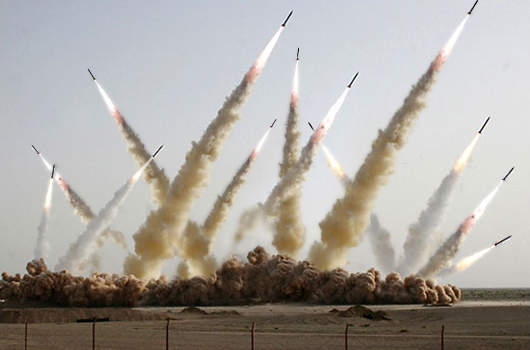
Getting Rid of the Alpha Strike Problem
Nowhere is this more evident than in the case of the Alpha Strike problem, where one player’s army is devastated on the first turn of the game to such a degree that they are unable to recover. This is almost exclusively a feature of I-go-U-go game systems, because it is only in them where one player has the chance to take all of their actions and do all of their damage before the other player can respond. In a game of alternating activations, it usually isn’t even possible to do this kind of sudden, overwhelming damage unless one player is so massively outplaying the other that the match would’ve been trivial no matter what.
Alpha strikes are a problem because not only do they remove interaction (you can’t do anything if your models are dead), but also because they make “comback mechanics” harder. Comeback mechanics are important for maintaining player engagement in a game, although they tend to be less present in wargames than in other board games. However, they still should have some place, because they offer a way for a player who is on the back foot to fight against the cascading advantages of the player who starts to pull ahead. After all, if you are winning (by virtue of having killed more enemy units, etc) it becomes easier to increase the lead by which you are winning, which in turn makes it easier to increase you lead even further, and so on and so forth until you are so far ahead your opponent has absolutely not chance of catching up. This kind of positive feedback loop is extremely detrimental to gameplay and needs to be avoided if at all possible- and alternating activations can help to slow this process, since they are generally less lopsided for the advantaged player.
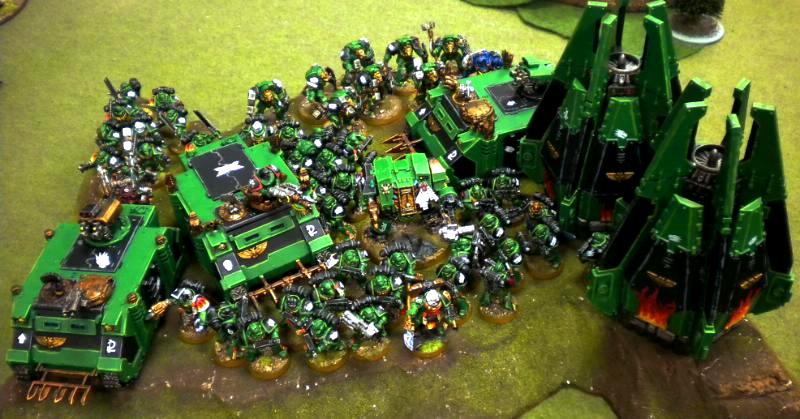
Armies Look More Like Armies
What do we mean by this? Well, in short, you are more likely to see a variety of units under most alternating activation systems, and more visual variety in armies is generally appealing to players. For the reason why, we need to dig a little deeper into the mechanics of the thing.
In alternating activations, there is a lot of value to being able to control when you activate your units- that is to say, whether you do so before the enemy (and thus pre-empt their own activations by wounding or destroying units) or after the enemy (allowing you to respond to what they have done with perfect information.) These advantages are roughly analogous to the advantages of first turn and second turn, respectively, in an I-go-U-go system such as 40K, which I assume the reader is familiar with. However, the key trick with alternating activations is that when the two players have differing numbers of units, they player with more units will have a lot of control over when they choose to activate their units, allowing them to freely choose between the “first player” and “second player” advantages for each unit and each time they activate.
This flexibility means that players are naturally incentivized to bring a larger variety of units- some strong and expensive units, to take advantage of activating at a particular time, but also a large number of smaller, cheaper units so that they can outweigh the enemy’s total activation number and thus control the sequence of the game. This counterbalancing forces mean that players will want some units from each selection and thus naturally have a certain amount of variety in their armies, even all other factors aside, rather than trying to double down on a single, powerful strategy or by bringing the maximum possible number of a small handful of efficient unit types. This variety is generally more aesthetically appealing and thus more likely to not only make players happy with what they are bringing to the table but also to feel like armies are “real” to an observer or opponent, rather than just a collection of rules that are assembled in the most efficient way possible.
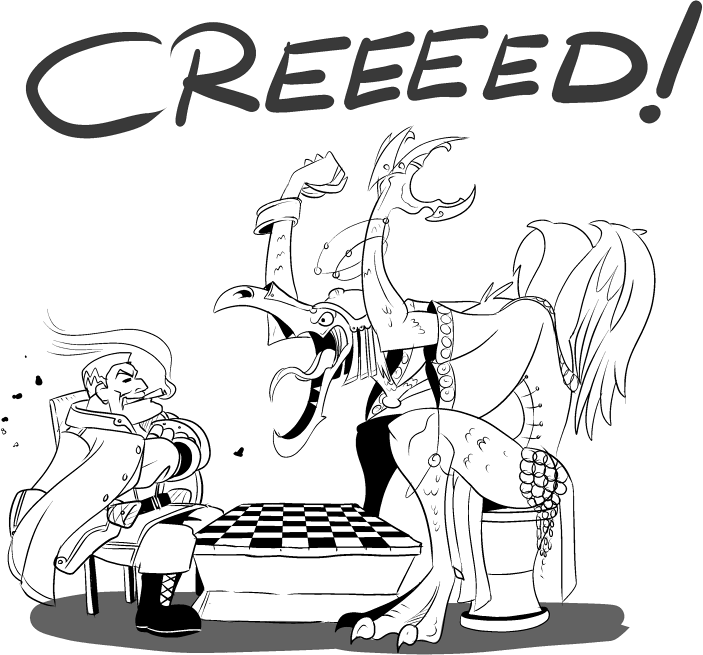
Greater Rewards for Strategy/Tactics
Now, I don’t intend to say that alternating activations are strictly better than I-go-U-go, as they both serve different purposes and have different advantages, but one of the advantages of alternating activations is that it allows for more interaction, and more interaction (as we already covered) means that player skill and foresight is generally going to be more rewarded. When there are more decisions to be made and more possible plays that are viable, that also means there are more “correct” and “incorrect” plays and thus more ways for players to leverage their knowledge of the game and its rules or their knowledge of what the opponent is going to do.
In I-go-U-go this is more limited, because the decision trees are more limited; I can’t interfere with your plan for a given turn much because you can enact that entire plan with essentially no interaction from me. If I can’t interact with it, I can’t interfere with it, plain and simple. I can try and cause your plan for next turn to fail, but that is only a single action point I can take, whereas with alternating activations I might have many chances to interfere with you in different ways. If I’m smart, that rewards my smart play- and if you’re smart and can head off my interference, that forces me to waste resources to no effect and rewards your smart play. In both cases, the additional interaction means that player skill is better rewarded.

So What?
Alright, so I’ve made my arguments- maybe I’ve convinced you and maybe I haven’t, but obviously no single player is going to be able to change the rules on their own, so what, exactly, am I arguing this matter for? Well, it’s simple- while no single player can make the change, opinions from enough players can potentially do so, especially if those opinions are carried through to the game designers.
Games Workshop isn’t unfamiliar with the dichotomy between these two systems of play- in fact, many of their games already use alternating activations, including skirmish games such as Necromunda, Kill Team, and others. I don’t think it’s a stretch to extend these rule systems- and the lessons learned from them- to “proper” 40K as a game, especially because it would potentially solve so many of the issues that are plaguing the game right now. Would it solve everything? Certainly not, and it would raise issues of its own in terms of how to change the designs and rules of various units, but I think it could very plausibly be a positive step forward for the game.
It may be that Games Workshop and their rules team and even playtesters have already started work on 9th Edition- I would hardly be surprised to learn that this is the case, though I don’t have any insider knowledge on the subject. Game design is a long and slow process and creating an entirely new edition is a ton of work. Whether this is the case or not, however, I’d like to put this idea out to the community to think about and discuss- would the game be better served by transitioning its activation system away from I-go-U-go? I’ve made my case for why I think it should do so here, but raising the issue is only the first step to actually pushing it. And whether it convinces anyone or not, the real point is to get people thinking about game design and what that means- how the choices in the game affect how we play it and how we perceive it. What’s really important here is not the success or failure of a single argument, but the intentionality of observing game design; that is, to truly look at the rules and understand why they are the way they are and what that means. Games are just games, but in understanding them and the rules we set for them we can open ourselves up to also understanding the other rules that govern our lives- the rules we set for ourselves about how we behave and act as well as the rules others set for us. In examining them and understanding their implications, we can understand what people tell us the rules do as well as what they actually do, and in doing so move beyond a simple acceptance of those rules to a comprehension of them in their totality.
Also seizing sucks and everyone hates it, even the people who think it’s necessary, and alternating activations mean seize becomes basically meaningless. So there’s that.


Interesting read. Doesn’t AOS have this style of gameplay?
I know Bolt Action has a unique dice system for unit activation that provides an interesting layer of strategy. If your not familiar with it, you basically get a dice for each unit you have and likewise for your opponent, then they get put in a bag and one gets drawn at random and depending on whose dice gets drawn they can pick a unit to activate. It makes the game much more random to represent the various levels of initiative but adds a layer of strategy with “counting dice” like counting cards. You can predict if you opponent got most of his dice in a row yo u will be lined up most likely to activate a bunch of units at once.
Bolt Action’s system is good and has some interesting outfalls; in actuality, very few games use “pure” alternating activations, usually going with some variation on the idea. There’s definitely a lot to like from BA and other games in terms of those kinds of ideas.
No. AOS is worse than 40k because not only do you have the old IGOUGO full turn activation that 40k does, AOS has the potential for DOUBLE TURNS, which lets players take two full turns before their opponent gets to respond.
That is the big sticking point for AoS that keeps people away but the experienced players almost all say they either don’t mind it or like it. It’s an acquired taste with AoS. I think the game is a lot of fun personally but also think both 40k and AOS would benefit form some form of alternate unit activation.
There’s survivor bias at work here : of course the people for who this is a dealbreaker won’t be veteran of AoS.
A simple system I devised some time ago for a ww2 aerial dogfight game might have some use.
Split a pack of cards between two players, one gets all the red and one all the black. Assign a card to each of your units. The face value is just a label, irrelevant except for the colour and the aces. Aces are assigned to super elite units/heroes, or can be omitted for simplicity. You declare which card is assigned to each unit, no need to keep it secret.
Remove unused cards and shuffle all the assigned cards together and place them face down. Draw the top card and activate the unit it represents. In my aerial dogfight game you were forced to move that unit, but in 40k you could elect to just miss that unit’s turn. Cycle through all the cards so each unit gets to activate once. Then shuffle the cards and repeat. Each time through the pack is a round.
Aces: When you draw an ace you can choose to activate the unit as above, or you can hold the card on the table face up waiting for later in the round. Then carry on as normal. At any time during the rest of that round you can interrupt the sequence by playing the ace and immediately activating your hero/unit, even between drawing another unit’s card and activating that unit. Unused aces are returned to the deck at the end of a round, losing that hero activation. If both players hold an ace, the second ace player can interrupt the first ace by declaring it straight after the first ace is declared.
Need more hero cards? Use the pictures instead of or as well as the aces, although it then requires a system to keep track of who interrupts who.
Some degree of randomness can definitely add interest to the cycle of alternating activations, although I think the level of complexity that assigning specific units to specific cards creates is perhaps too much for 40K- especially if both players end up having more than twenty-six units in their army. However, for a smaller skirmish-style game (especially one that is intentionally chaotic, as one would expect a frantic dogfight to be) I think it could be very good.
If you find the mechanic of IGO-UGO truly so fundamentally flawed, it begs the question why play 40K at all?
There’s tons of games out there using all kinds of different mechanics of alternating or initiative-ranked or semi-randomized or whatever type of activation in all flavors you can think of.
If there’d be a … dunno … Infinity or X-Wing player agonizing about the fundamental mechanics of the game seem problematic, outdated and tactically unsound to him and he wished they’d use a different game play, they could just switch games.
It’s not like the market is starved of options. Why keep ordering vanilla, agonizing and editorializing how it just doesn’t ever truly taste like chocolate, when you could just order chocolate?
I’m sorry that you didn’t understand the article.
In all seriousness, do you really consider that IGO-UGO is a core element of W40K ? That’s some seriously heterodox idea, and I am interested to know why (if it’s the case)
I think the game would fundamentally be a different game, if it would switch to a different format like alternating activation. Yes.
And I played games with alternating or initiative-based activation, etc.. and IMO they are game-play wise inferior (for my taste) in aspects of tactics, balance, etc.. it’s one reason I switched to 40K, sure.
People can of course have different preferences, but it just seems irrational to me, both from a player perspective and from a game publisher’s business perspective to try and turn Game A into Game B when Game B is already out there.
I like it, but how do you handle auras? If each unit activates on it’s own it will be hard to keep auras covering all the units they need to, especially in mobile armies. you would have to move your aura unit first which could make it vulnerable to the enemy’s next activation. Does alternating by detachment make more sense?
Could make it so they benefit if start or end their move in aura. Or change auras to be X units within 12 inches, etc.
It would make managing that sort of thing potentially more difficult, to be sure, but other games (e.g. Malifaux) work with such a system just fine. It changes how you play and the relative value of some auras, but doesn’t make them strictly worse- remember, you can also take advantage of the fact that auras would be “timed” to pull tricks like acting with a bunch of units surrounding, say, a Captain to have each one of them shoot and then have the Captain jump away to punch something with the final activation of the turn.
First, from your lips to GW’s ears, may something like this come to pass.
Auras don’t need reworking at all. Just run similar to Kill Team: I move all mine, you move all yours, then we alternate shooting. Auras still work. What needs to be worked out is how move/fire/charge works, as KT rolls charge into movement. I’m okay with that, but it’s a significant change to melee balance. We’ve tried strictly alternating everything past the Move phase, and chargers ,unless they’re very well positioned, tend to get shot to pieces.
But that said, I’m pretty sure there’s a workaround. And I’d love to see that in 9th. Igo-Ugo puts far too much weight on who goes first, and I’d note that every GW game after 8th and AoS has had some kind of AA. Optimally, I’d like to see orders, like Apoc or BA.
To be honest, I’d argue 40k could do with having far fewer auras in the first place.
IMO they are one of the worst things 8th implemented.
They have a system for alternating in Kill-Team, and it’s one of the reasons I like the game. Could modify that to apply to units instead of model by model. Not sure how that changes the length of games (in theory, I think it would be about even, maybe even less, once people adopt to it).
The old Epic 40,000 (with square infantry bases) used alternating deployment, if I remember correctly. That was a good system for the time (aside from Eldar hover tank’s pop-up attacks), though I’m not sure how it would hold up now. I have vague memories of playing Rouge Trader era as alternating, which I’m not sure the rules supported. That was the Wild West though (ugh, follow fire, terminators saving on 2d6), so probably not worth mentioning.
In thinking of edge cases and ability interactions for 40k, it does seem like it’d require a massive, massive retooling of the game. A unit can have such wild swings in relative power – a Death Jester, Leviathan Dreadnaught, 30 Devilgaunts, and a blob of Ork Boys are all a unit, right? Maybe the fun would be trying to navigate that power differential.
Either way, I’m having trouble imagining how a low-model count army plays effectively against a high model count army in alternating activation since the high model count army has so many more “moves.”
Might be an actual differenciating point between units as well as a way to make MSU less powerful ?
For the activation count, the devil is in the details. Some alterned activation system give the guy with less activation a number of “blank” activations who mean they can force their opponent activate twice. If too generous, that kind of system make it much stronger to have few drops
As for a massive retooling of the power level of stuff, that’s true but also pretty much the case with any edition of W40K.
I’m certainly not opposed to the idea of I-go-you-go making its way into 40k, but that would require a fairly substantial redesign of the rules and mechanics. The new Apoc rules manage this pretty well, with dividing the army into 3 ‘detachments’ that alternate, rather than doing so strictly unit by unit. The disparity between unit values, activating a squad of cultists versus activating a knight, make balancing a pure I-go-you-go challenging at best.
Seeing as 40k already uses a max of 3 detachments, that might actually be a good way to transition it.
It certainly would require a major redesign of the game- but so did 8th Edition, for example, and I think that overall the community is pretty pleased with the results of that experiment. Games should evolve and change for the better as the designers learn more and understand the rules better.
I agree with the problem and solution to an extent, but I still wonder if the problem might not just persist in players taking MASSIVE units.
Activating a 150 point Sister of Battle squad is a much different beast from activating a 600+ point Crisis bomb or Knight.
This change would make such units autotakes in any army that can field them, and disparage armies that cannot.
Taking high-investment units like that Crisis Bomb has a cost of its own, though, and while such a unit can have a significant impact on the battlefield if it is able to activate early, it won’t have the same kind of impact that shooting with an entire army would.
Many games with alternating activations have high-cost units that don’t break the game, because there is an inherent balancing factor in most cases; if you spend 600, or 900, or 1200pts of your army on a single model, that is going to limit how many other models you can field- and thus you will be at a significant disadvantage when it comes to total model count and thus activation sequence. When you are always forced to activate your single big guy before the enemy activates all of their strong units, it ends up being a significant disadvantage.
I’m not necessarily disagreeing with your overall point, but there’s a couple of specifics that sat wrong with me.
“It’s not at all unusual for an army to consist of 20-30 units (and sometimes even more), every one of which that player will have to activate on each of their turns.”
Surely this problem would carry over to AA? Keeping track of activated and non-activated units would even get more confusing than in IGUG considering that your opponent is activating his units interspeded with yours.
“Armies Look More Like Armies”
This whole section is shaky at best. It makes the assumption that the main differentiating factor between units is their total points cost so you’d have to incorporate both high- and low-cost units in your army, which is fair enough, but it doesn’t follow that this would lead to more diverse and fluffy armies as opposed to spamming the most optimal options. If anything it’d be the opposite — take whichever unit is cheapest at its minimum (not unlike current considerations for battalion-filling troops, but even worse) and spam it however much you think necessary to give you control over unit activations, then continue with your army building as normal. It just adds another artificial measure of value to a unit where being cheap and numerous is a value all its own regardless of what the unit actually does.
Moreover, it kinda ties into a general issue I have with the concept of AA as applied to current 40k — it strictly rewards MSU. MSU is already heavily incentivized through mechanics like target selection, morale, Slamander rerolls and targeted debuffs, with the main counterpoint being buff stacking (mainly seen in “bomb” units). Tipping the scales even farther in its favour (and in such a “gamey” way to boot) isn’t something I’d consider a positive.
My proposed solution to this would be to find a middle ground, as it were. Specifically, divide armies into chunks of fixed sizes (500 or 400, maybe more to allow for LoWs and such or make them variable within a certain range) or just consider detachments individually. Then activate those in an AA system, giving you some measure of the benefits of both systems while not incurring in the strict advantage of MSU as detailed above. Come to think about it, doesn’t Apocalypse use something like this for its activations? It seems like the least disruptive and most scalable solution if one were set on implementing AA into 40k.
>Surely this problem would carry over to AA?
Alternating would probably necessitate some kind of tracking mechanism for units, depending on how it was implemented, yes- but I consider that a fairly trivial cost, since some players already use markers to indicate which units have activated during their turn.
>It makes the assumption that the main differentiating factor between units is their total points cost so you’d have to incorporate both high- and low-cost units in your army,
I can’t back this up with anything absolute, obviously, since the article itself is speculative at best. But my experience with other games that use alternating activation systems (Malifaux and Infinity) I found that this wasn’t specifically the case. Players did bring multiples of the cheapest unit sometimes, of course, but often the opportunity cost there was high enough that it was worth spending a few more points to bring something more effective. (Also, such a system presumes that all units in the game are going to be recosted to represent the inherent value of simply _being_ a unit on the table.)
>My proposed solution to this would be to find a middle ground, as it were. Specifically, divide armies into chunks
This is very close to how Infinity does things, actually.
There would definitely need to be a massive overhaul for it work.
One thing for sure is that charges would need to be resolved before or alongside shooting, otherwise combat might as well not exist.
I’ve toyed with idea before, and one cool way to help break the turn down into easier chunks would be to have a priority system based on battlefield role. That would make a fast attack unit, assuming it had the highest priority, actually feel fast, rather than just able to go further (sometimes..).
At 40k tournaments ive seen armies of 1 unit and armies of 40+ in malifaux your insentivised to keep your army between 7 and about 12 models. This is close in nymber so AA works well.
I don’t get the people saying AA benefits MSU unless your pulling dice from a bag. I pick an IK you pick a guard squad I pick an IK you pick a guard squad – just ensures knights and elite alpha strikers effective go first every game
But you can pull dice from bag. Or use a system ala Star Wars Legion that makes you pull tokens but also gives you some control over key units. Its not like you have to take AA with all it’s core problems. There are years of game design experience on how to soften the edges.
I have implemented alternate activation in both 40k and AOS as-is for many years. It works fine without a major overhaul of the system.
It was the only set of house rules I have implemented in 20+ years that had more positive than negative reactions.
The negative reactions typically came from the “i hate all houserules” crowd or the people that were upset that their alpha strike was suddenly neutered since you didn’t just stand there taking it in the face all turn.
I won’t touch AOS or 40k these days until some form of alt activation is in place.
I agree with the last statement. Or I would if they could stop making more stuff I’d really like to play. Aetherpunk Dwarfs, finally Admech and Genestealer Cults. I’m not even asking for a good game. I’d never hold the company worth millions to the same high standards as the people making great games in what amounts to a glorified garage in direct comparison. But just enough so I don’t want to tear my face of and eat it would be nice. AOS seems to sort of get there. At least it doesn’t have detachment salad.
Great article! When we play multiplayer games we use alternating phases: Each battle round we roll off to determine which order we activate, then the winner does their movement phase, followed by player 2, etc. I’ve found it to be a very simple and effective way to keep players engaged, and to introduce more reactive strategy for players going 2nd/3rd/4th.
There have been many different activation systems over the last two hundred years of wargaming – mainly starting with the Prussians assessing whether their plans would work . IGoUGo comes from chess AND also from the attacking surprising the foe.
IGoUGo works well with inexperienced players or in a tournament setting where there are multiple games in a day/week-end.
Kill Team style activations work well with EXPERIENCED players and a small number of models designated with tokens – but can seem strange to novices. It’s now got reduced to a 2D tournament game (so you can keep track of the tokens) which spoilt the game for me.
One style we used with 1:300 tank battles (pre-W40K) was roughly I move, you fire, you move, I fire. That system was never popular as it took a knack to win.
We’ve also seen how unpopular INTERRUPTIONS are to W40K – I hated how the Ynarri soup could stop me virtually every turn. That made killing their units an absolute pain.
Card activation systems came out eighty years ago – they work well with small numbers of units. BUT cards are easy to manipulate (I’m a professional magician!). I quite like the Bolt action “dice from a bag” and will be using it for a narrative campaign.
AoS has their IGoUGo / double potential turn. The competitive players made it clear they didn’t see a problem with this. One of those (Ben) is now head of development. Another alternative was seen in last nights televised AI game – four players, with cards drawn out of a hat for initiative, then different phases for move/fire/end etc that kept everyone involved. It worked well but there were only twelve ‘planes on the board. BF has a similar way of deciding which opponents go first – but only four adventurers and upto four sets of attackers.
Almost every single GW game has a different mechanic. That’s one of the nice things about using their games. BUT most shops sell games from hundreds of different manufacturers which use different activation methods again. Surely it’s the players choice which they CHOOSE to use. Personally, I don’t use any game that involves a chess clock or in W40K any non-GW missions. That’s my choice after over 40 years of playing. I like the simplicity of IGoUGo and WYSIWYG at a tournament level for historical and sci-fi battle games.
Over all, W40K is a simple game using toy soldiers – that makes it popular with many people especially 12+, often figures are purchased and painted but never played. Some want to make it a sport but that’s far from the case.
Not having done this at the one time they overhauled everything pretty much smelled of comittment to the stone age for the next decade to me. On the other hand I think you put more thought into this issue in this one article than GW has ever done. Do they haven have game designers with acutal industry experience instead of their own crop?
The fact that you can still go do your taxes while your opponent does their turn in a game already as massive and unwieldy as this just astounds me. And I’m sitll just a tiny bit bitter that I was assured that wouldn’t be the case on this very site after the playtest phase.
I think implementing the Kill Team alternating turn style and overwatch rules to 40k will make the game a little more interesting.